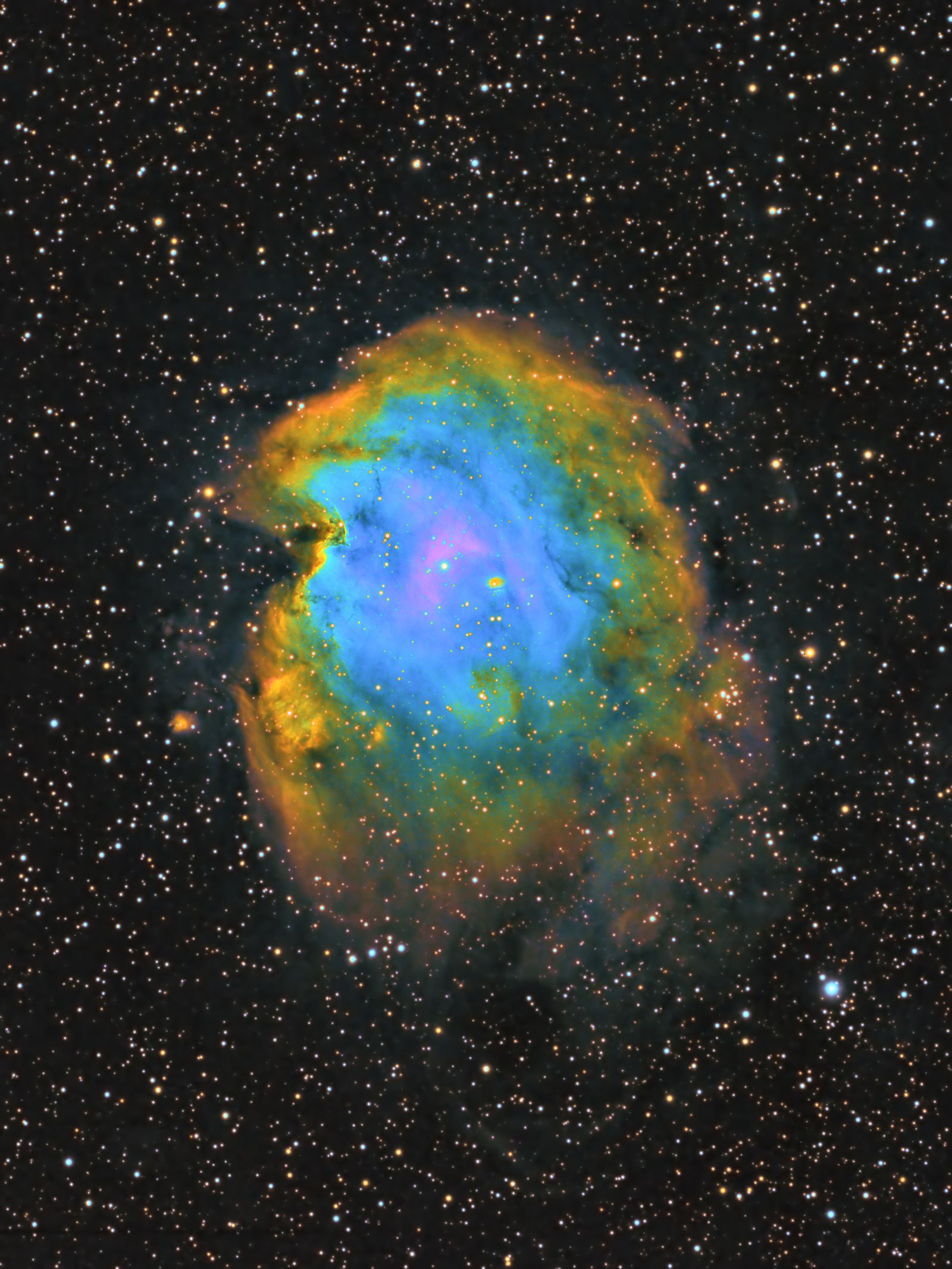Monkey Head Nebula (Hubble Palette)
 Click image for full size version
Click image for full size version
March 19, 2021
The Monkey Head Nebula (NGC 2174; Sh2-252) surrounds open star cluster NGC 2175 and lies about 6,400-7,200 light years from us. The nebula is a stellar nursery, where new stars are forming. In addition to the reddish emission nebula, it contains bluish reflection components. One is at lower right of the nebula, and another is around the brightest star inside the nebula. This field is located in the northern part of Orion, just below the feet of Gemini. This image was taken through narrowband filters that passed emissions from sulfur, hydrogen and oxygen to the camera. This false-colour image shows some of the chemistry of what is going on within the nebula. I have also separately posted a natural-looking broadband image. Although I find the natural look more aesthetically pleasing, the narrowband palette gives us a look at how the gases vary throughout the object, and give it a more three-dimensional appearance. I used the star colours from the broadband image to make the stars look more natural in this narrowband view.
Being set in the winter Milky Way, the image is full of stars that show a range of colours varying from orange-red to blue-white based on their temperature (blue is hottest; red coolest).
Tekkies:
Acquisition, focusing, and control of Paramount MX mount, with TheSkyX. Focus with Optec DirectSync motor and controller. Guideing with OAG and QHY5III-290 camera. Automation with CCDCommander. Equipment control with PrimaLuce Labs Eagle 3 Pro computer. All pre-processing and processing in PixInsight. Acquired from my SkyShed in Guelph. Average transparency and seeing. Data acquired March 2-14, 2021 in a mostly moonless sky.
Sky-Watcher Esprit 150 f/7 refractor and QHY 16200-A camera with Optolong UV/IR, H-alpha, O(III) and S(II) filters
Chrominance (for stars only): Takahashi FSQ-106 ED IV @ f/5 and QHY367C Pro one-shot colour camera with Optolong UV/IR filter
Ha: 26 x 10m = 4hr20m
O3: 8 x 10m = 1hr20m
S2: 13 x 10m = 2hr10m
OSC: 106 x 5m = 106x5m = 8hr50m (stars only)
Total for SHO image: 7hr50m
Data Reduction and Cleanup
The WeightedBatchPreProcessing script was used to perform calibration, cosmetic correction , registration and integration of all frames.
Chrominance
Creation and cleanup: The S2, Ha and O3 were combined to make an RGB image. DynamicBackgroundExtraction and BackgroundNeutralization were applied to the image.
Linear Noise Reduction: MultiscaleLinearTransform was used to reduce noise in the RGB image. Layer settings for threshold and strength: Layer 1: 5.0 0.85 Layer 2: 4, 0.75 Layer 3: 3, 0.64 Layer 4: 2.0, 0.2 Layer 5: 1, 0.1.
Stretching: HistogramTransformation was applied to make a pleasing, bright image, with background set to an intensity of approximately 0.10
Luminance
Creation of Synthetic Luminance: ImageIntegration was used to make a noise-weighted average of the three narrowband masters. This was used as synthetic luminance.
Deconvolution: A star mask was made to use as a Local Deringing Support image. A copy of the luminance image was stretched to use as a range mask. Deconvolution was applied (100 iterations, regularized Richardson-Lucy, external PSF made using PSFImage script with 50 stars).
Linear Noise Reduction: MultiscaleLinearTransform was used to reduce noise in the background areas, using an internal mask to protect bright structures. Layer settings for threshold and strength: Layer 1: 4.0 0.9 Layer 2: 3.0, 0.75 Layer 3: 2.0, 0.6 Layer 4: 0.5, 0.2.
Stretching: HistogramTransformation was applied to make a pleasing, bright image, with background set to an intensity of approximately 0.1.
Combining Luminance and Chrominance
LRGB Combination: The synthetic luminance was applied to the chrominance image using LRGBCombination with default settings.
Additional Processing
Nonlinear Noise Reduction: TGVDenoise was used in L*a*b* mode to reduce noise with a mask used to mainly target the background areas and protect the stars (max. 1000 iterations and convergence selected for both luminance and chrominance).
Contrast Enhancement: LocalHistogramEqualization was applied twice using a mask to select the bright parts of the nebula and protect stars and background. The first pass was with a scale of 50 (max contrast 1.5, strength 0.25, 1 iteration), followed by a scale of 150 (max contrast 1.5, strength 0.27, 1 iteration).
Sharpening: MultiscaleLinearTransform was used to sharpen Layers 2 and 3 with strengths of 0.4 and 0.1, respectively. A mask was used to limit sharpening to high-signal areas and to protect the stars and background regions.
Hue Adjustment: The green tones were transformed towards blue, and yellows towards red, using CurvesTransformation’s Hue adjustment. SCNR was applied with a strength of 0.20 through a Green mask generated with the ColorMask script.
Star Colour Adjustment: The Hue channel was extracted from the natural-colour RGB image using ChannelExtraction in HSV mode. The result was used to replace the Hue channel of the narrowband image using ChannelCombination through a star mask, to impart a more natural colour to the brighter stars. Processing details for RGB stars source image
Final Steps: Background, nebula and star brightness, contrast, saturation and hue were adjusted in several iterations using CurvesTransformation with masks as required. The DarkStructureEnhance script was applied with a strength of 0.25. ICCProfileTransformation (sRGB IEC61966-2.1; Relative Colorimetric with black point compensation) was applied prior to saving as a jpg.






WOW, THIS ONE JUST BLEW ME AWAY11
WOW, THIS ONE JUST BLEW ME AWAY!1